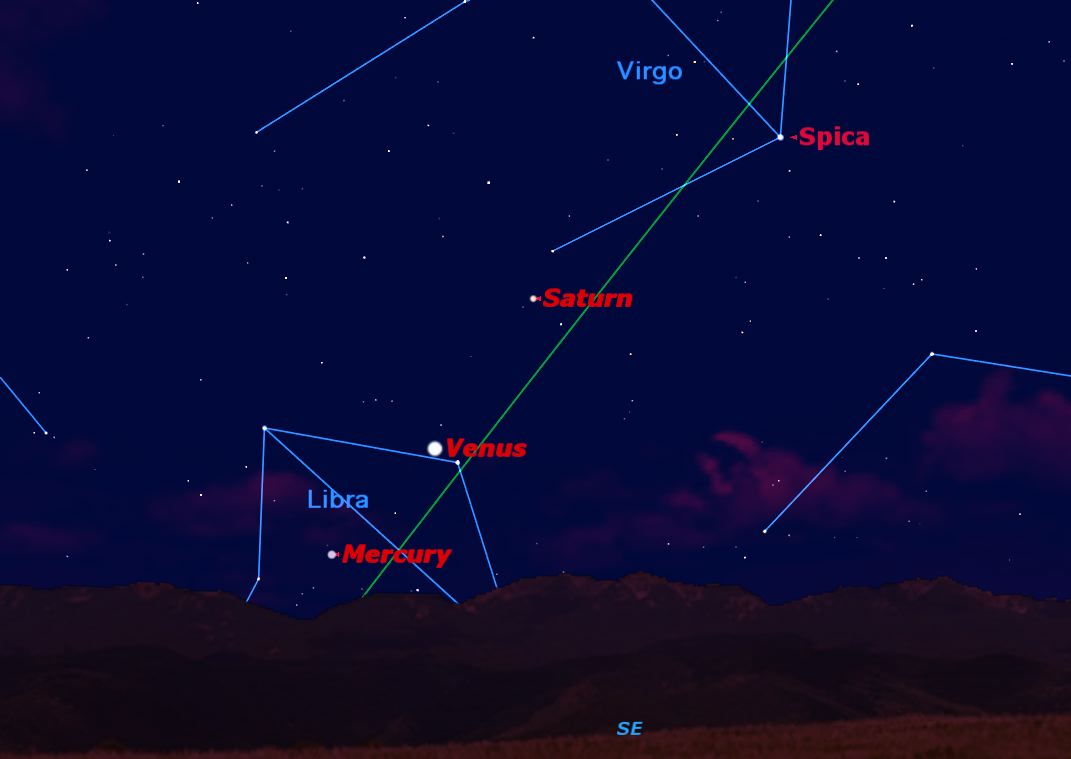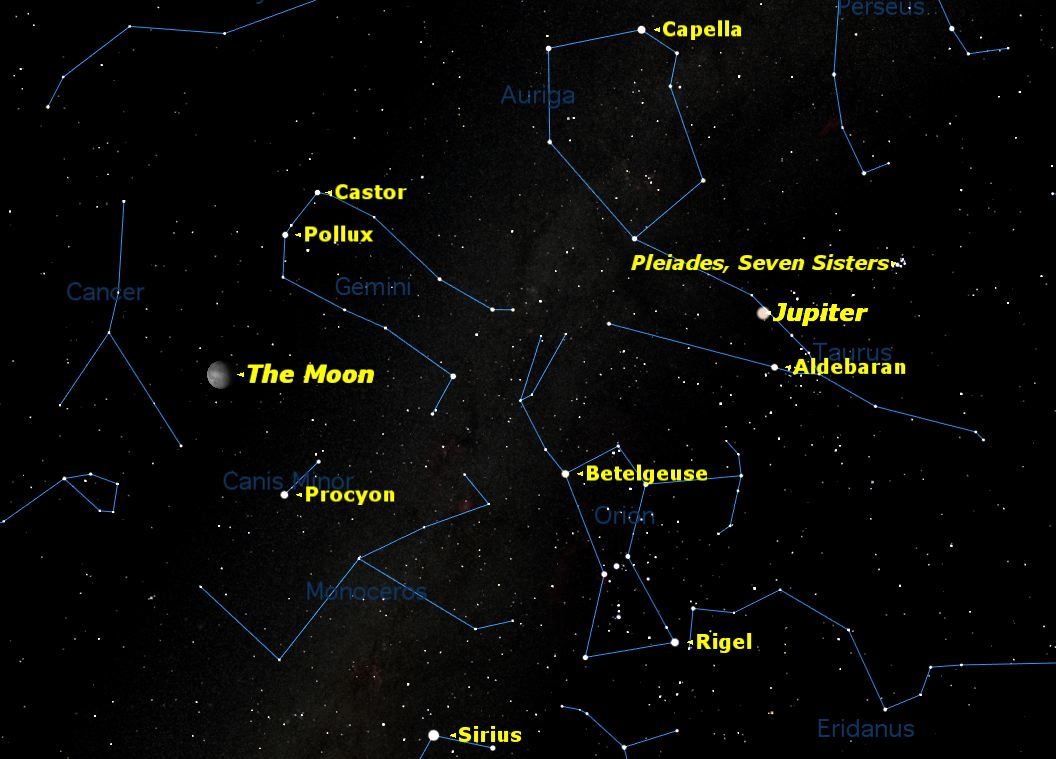See Mercury at Dawn and Jupiter All Night Long

This is a great week for planetary observers. Mercury is in its best position as a "morning star" for observers in the Northern Hemisphere while Jupiter is at its biggest and brightest for nighttime observers all over the world.
First let's take a look at Mercury's dawn sky performance. Because Mercury never strays far from the sun, it is usually a challenging object to observe.
Only rarely does Mercury reach maximum elongation when the ecliptic is at a steep angle to the horizon, so that it can be spotted against a fairly dark sky. Each year this happens once in the evening and once in the morning, and this is the week to look for Mercury in the morning sky for northern observers. As a bonus, the brighter planets Saturn and Venus point the way to find Mercury's tiny disk against the glow of dawn.
Even when well placed, Mercury can be a challenge unless you have a clear sky on your eastern horizon. Sweeping with binoculars will often help to first locate Mercury. Once located in binoculars, it is usually quite easy to see with the unaided eye. A telescope will show it as a tiny "half-moon." [Amazing Night Sky Photos by Stargazers]
Jupiter in the night sky
Jupiter, on the other hand, dominates the sky all night. It reaches opposition, a point exactly opposite the sun in our sky, on Dec. 2, and moves from the morning sky to the night sky.
On the nights around opposition, it is in the sky all night long, rising in the east as the sun sets in the west, and setting in the west as the sun rises in the east. When opposition happens this close to the winter solstice in the northern hemisphere, Jupiter is above the horizon for a full 15 hours.
Get the Space.com Newsletter
Breaking space news, the latest updates on rocket launches, skywatching events and more!
If you have a telescope good enough to show you the details of Jupiter’s cloud belts, you can watch a full rotation of the planet, which takes a little under 10 hours. You should be able to see the Great Red Spot at some point during any night, and might even see it twice in one night.
Jupiter’s Great Red Spot is the longest-lived atmospheric feature in the entire solar system. Its position has been tracked by astronomers since 1894, and there are observations of it going back more than a century earlier than that. At times the Great Red Spot has been a large brick-red object, three times lager than the entire planet Earth. Currently it is a pale remnant of its former self, so that observing it can be a challenge.
Jupiter's big (red) spot explained
What do you need to spot Jupiter's Great Red Spot?
First of all, a good quality telescope with at least 6 inches (150 mm) aperture. Secondly, a night with very stable atmospheric conditions on Earth. Finally, your timing needs to be right, because the planet Jupiter rotates faster than any other planet.
Half the time, the Red Spot is on the side of the planet you can’t see. Even when it’s on the side facing Earth, it’s often lost in the haze on Jupiter’s limb. It is really only at its best within an hour on either side of its time of central meridian transit.
As already mentioned, the Red Spot’s position has been tracked for over a century. The problem is that it is not an object fixed to the planet itself, but is a huge storm system, mostly confined to a constant latitude, but drifting over time in longitude.
If you have a computer program which shows the position of Jupiter’s Red Spot, it is probably wrong. That’s because, unlike most things depicted in planetarium software, the Red Spot does not move in a uniform predictable manner. You have to tell your software the current position of the Great Red Spot.
Consult the manual for your software to find out how to set the longitude of the Red Spot. Its current longitude, as of late November, is 188° in Jupiter’s System 2 longitude system. To get the Red Spot’s most up-to-date position, visit: http://jupos.privat.t-online.de/rGrs.htm
The red dots mark the actual raw measured positions of the Great Red Spot in longitude (across the chart) against the date (down the chart).
There is also this simple calculator via Sky & Telescope magazine, which will give you the approximate times the Red Spot transits Jupiter’s central meridian for any date.
Choose a time within an hour of one of these transit times.

Jupiter's Great Pink Spot?
The last thing you need to know when looking for the Red Spot is that it is no longer red. Its current color is best described as a very pale salmon pink. Most of the time the Red Spot is not visible by where it is, but rather where it isn’t. Because it is lighter in tone than the South Equatorial Belt in which it resides, it is most often seen as a hollow in the south side of that belt, sometimes called the Red Spot Hollow.
Be forewarned that most photos of Jupiter have been processed to exaggerate the contrast and colors of Jupiter’s atmospheric features. The real planet has much fainter markings than you see in pictures.
Also be prepared to use averted vision to detect the faint markings: Look slightly off to one side of the planet. Finally, be patient. Planetary features only pop into view now and then when we get a steadier moment in our atmosphere.
This article was provided to SPACE.com by Starry Night Education, the leader in space science curriculum solutions. Follow Starry Night on Twitter @StarryNightEdu.
Join our Space Forums to keep talking space on the latest missions, night sky and more! And if you have a news tip, correction or comment, let us know at: community@space.com.

Geoff Gaherty was Space.com's Night Sky columnist and in partnership with Starry Night software and a dedicated amateur astronomer who sought to share the wonders of the night sky with the world. Based in Canada, Geoff studied mathematics and physics at McGill University and earned a Ph.D. in anthropology from the University of Toronto, all while pursuing a passion for the night sky and serving as an astronomy communicator. He credited a partial solar eclipse observed in 1946 (at age 5) and his 1957 sighting of the Comet Arend-Roland as a teenager for sparking his interest in amateur astronomy. In 2008, Geoff won the Chant Medal from the Royal Astronomical Society of Canada, an award given to a Canadian amateur astronomer in recognition of their lifetime achievements. Sadly, Geoff passed away July 7, 2016 due to complications from a kidney transplant, but his legacy continues at Starry Night.









